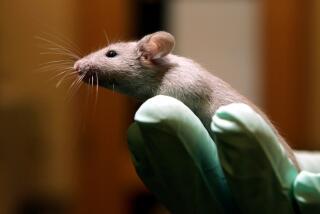Several Animals Said to Be Bearing Clones
WASHINGTON — Cows, sheep, pigs and monkeys in research laboratories around the United States and Europe are now pregnant with clones created by methods similar to those used to make Dolly the sheep, scientists reported at a two-day meeting that ended Friday.
At least one of the pregnant sheep is carrying a clone that has been endowed with an added gene, marking a significant step toward a long-standing goal of cloning animals that produce medically useful drugs in their milk.
But many other pregnancies involving clones have already ended in miscarriages, scientists said. And evidence is cropping up that many cloned fetuses have subtle genetic alterations that affect their development in mysterious ways--suggesting that this month’s recommendation by a presidential ethics panel to ban human cloning on safety grounds may be well-founded.
“Clearly it’s important for all the potential applications of this technology that we understand” these problems, said Ian Wilmut, the researcher from the Roslin Institute in Scotland who led the effort to make Dolly.
Wilmut spoke at the first international meeting on mammalian cloning to be organized since his team in February electrified the world by announcing it had grown a sheep from a single skin cell taken from another adult sheep. The conference, held in Arlington, Va., was sponsored by Mary Ann Liebert Inc., a New York-based publisher of scientific journals.
*
Tanja Dominko, a researcher at the University of Wisconsin, said a team there led by Neal First took skin cells from adult cattle and inserted those cells into cattle egg cells whose genetic material had been removed. The researchers then applied an electric current, as Wilmut did with his sheep cells, to fuse the two cells and make them start dividing into an embryo.
Of the many such embryos they have implanted into the wombs of cows--all of which are genetically identical to the cow that donated the ear cells--about 15 are still developing, with the oldest about 35 days old, Dominko said.
That’s about one-fourth of the total gestation time for cattle, and past efforts by the same team suggest that few, at most, of the pregnancies will survive to term. In some cases the problem appears to be improper development of the placenta, which provides nutrients for the developing fetus, but most of the failures are unexplained.
“We are losing embryos at every step of the process,” Dominko said. “If we ever want to make this procedure work, we have to understand why.”
In Scotland, Dolly was the sole survivor of 277 sheep embryos made from adult cells. Wilmut said she seems healthy today as she approaches her first birthday, and will be old enough to mate in the fall, providing an opportunity to see if she is fertile.
But in recent studies, Wilmut said, some of Dolly’s chromosomes underwent subtle structural changes usually found only in cells from older animals--evidence, perhaps, that they have retained a molecular memory of the fact that they are derived from a skin cell taken from a 6-year-old animal.
“Is she in some sense seven years old?” Wilmut asked rhetorically, adding quickly that the chromosome studies were very preliminary and that he was reluctant to draw conclusions from an experiment on a single animal.






